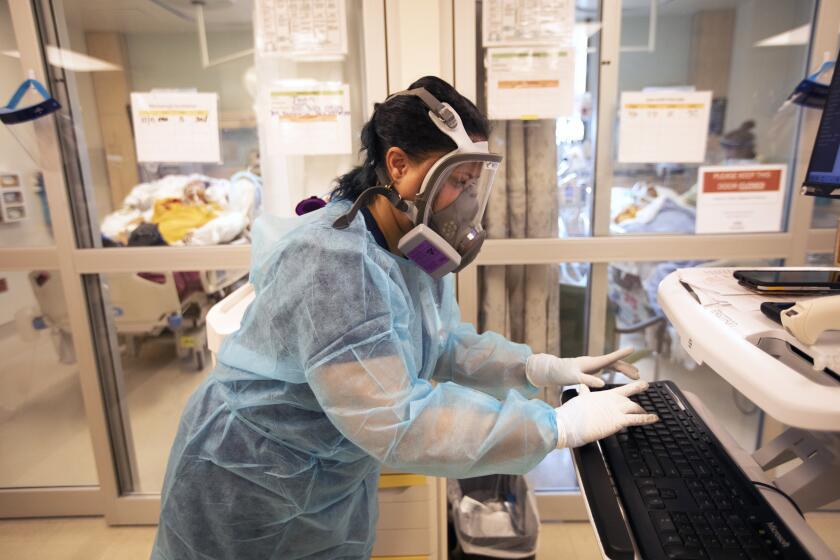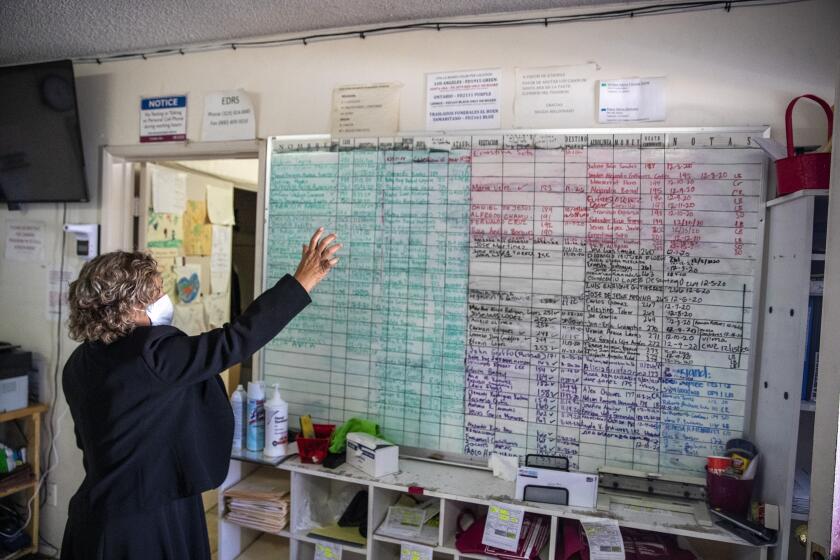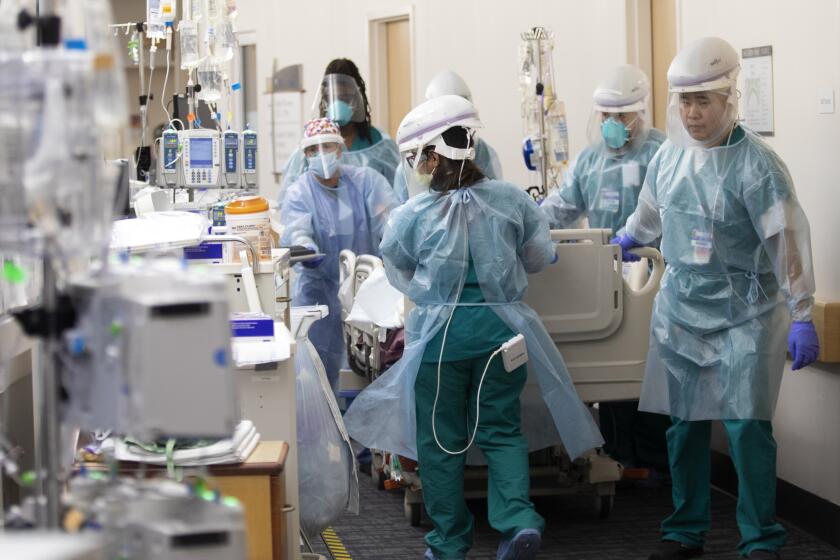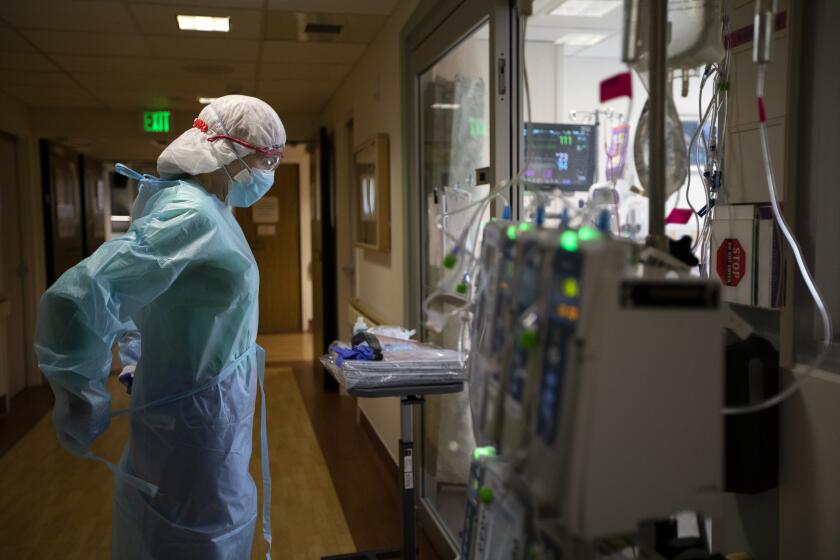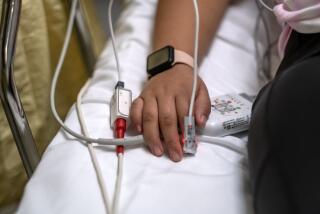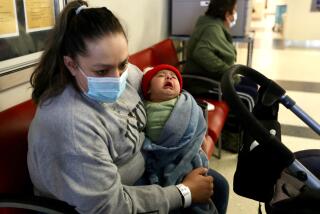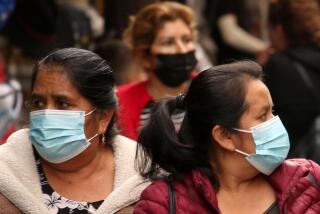L.A. County hospitals turn away ambulances, put patients in gift shop: ‘I’ve never seen anything like this’
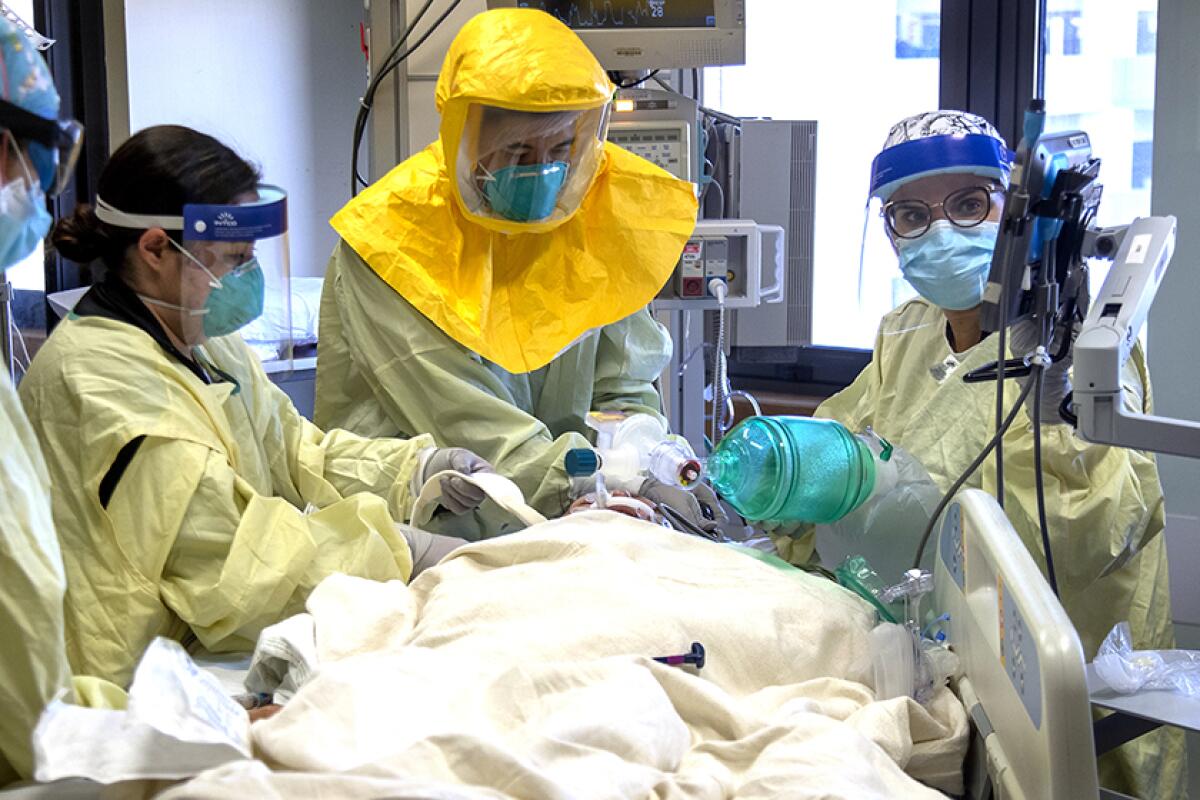
- Share via
At Los Angeles County-USC Medical Center, the breaking point came Sunday night.
There was not one available bed for at least 30 patients who needed intensive or intermediate levels of care, and the hospital had to shut its doors to all ambulance traffic for 12 hours. Some patients, including the very sick who required intensive oxygen, experienced wait times as long as 18 hours to get into the intensive care unit.
The front entrance of Community Hospital of Huntington Park was closed to the public Monday; the back of the building saw a steady stream of ambulances over the weekend, with one security guard saying the vehicles arrived as frequently as every half hour.
Hospitals in lower-income, densely populated and nonwhite communities face the greatest challenge in providing care, a Times data analysis finds.
And Memorial Hospital of Gardena on Monday was running at 140% capacity, forcing officials to ask for a four-hour suspension of new ambulance calls so it could move patients. The hospital is struggling to keep enough oxygen and supplies on hand amid the crunch of COVID-19 patients who need it.
“It’s a crisis — there’s no doubt about it,” said Memorial Hospital Chief Executive Kevan Metcalfe. “And they just keep coming.”
The crisis at Los Angeles County hospitals hit new levels as patients continued to stream in during the holiday weekend, and the medical system is bracing for a new wave of coronavirus spread arising from Christmas travel and gatherings. L.A. County’s cumulative COVID-19 death toll is expected to climb past 10,000 this week.
Hospitals are so inundated that they’ve resorted to placing patients in conference rooms and gift shops. But even so, many facilities are running out of space. Virtually all hospitals in L.A. County are being forced to divert ambulances with certain types of patients elsewhere during most hours. On Sunday, 94% of L.A. County hospitals that take in patients stemming from 911 calls were diverting some ambulances away.
“But soon, there won’t be any places for these ambulances to go,” said Dr. Christina Ghaly, the L.A. County health services director. “If every hospital is on diversion, then no hospital is on diversion.”
The number of people with COVID-19 inside L.A. County’s ICUs has broken records for 16 consecutive days, rising to 1,449 on Sunday, the most recent data available. Every day over the last week, there has been a net daily increase of 35 COVID-19 patients in ICUs — down slightly from 44 in mid-December but at a pace that’s packing even more critically ill patients into crowded facilities.
As of Monday morning, there were 54 available ICU beds across L.A. County, and half were for pediatric patients. Two-thirds of staffed ICU beds in L.A. County are filled with COVID-19 patients.
“All hospitals are experiencing this strain, but it’s especially more pronounced and more serious for some of the smaller hospitals,” Ghaly said. “Many hospitals have reached a crisis point and are having to make many tough decisions about patient care.”
Southern California mortuary and funeral home operators say they are having to turn away bereaved families because they can’t handle more bodies.
There was evidence of this Monday in Huntington Park. With Community Hospital closed to visitors, East 58th Street became a waiting room. Cars waited outside the packed hospital parking lot, headlights on in the rain, as passengers waited for loved ones inside. Occasionally, a passenger exited a vehicle, umbrella out, to approach the hospital’s new main entrance, the “ambulance entrance.”
A Los Angeles Fire Department ambulance arrived, sirens blaring, and the driver unloaded a patient on a gurney. A single blanket hung off the side of the gurney, not fully covering the patient from the rain.
Hospital staff took the patient’s temperature and gave him a wrist tag. After checking him in, the firefighters wheeled the patient back out to the parking lot and into one of two makeshift white tents. Behind the thin covering that served as the tent’s door, the patient could be seen shuffling to a seat as a hospital staff member, holding a clipboard, spoke to him.
At Gardena Memorial, officials used the four-hour suspension of ambulance deliveries to move some patients home — or at least out of the hospital’s 10-bed ICU and into an expansion area previously reserved for postoperative patients — to make room for 18 others in need of intensive care.
“You have to be very resourceful and creative and utilize your resources maybe in ways that you haven’t before,” Metcalfe, the hospital CEO, said.
It’s a task that is proving increasingly difficult, as those resources are dwindling. COVID-19 patients require “triple the amount of oxygen,” Metcalfe said, so supplies that might typically last a week now last three days.
Even oxygen storage tanks on the hospital grounds are draining quickly because of increased demand, he said. If a hospital were to run out of oxygen completely, it would be in “deep, deep trouble,” Metcalfe said.
L.A. was far more vulnerable to an extreme crisis from the coronavirus than nearly anywhere else in the nation.
“Patients that are on these respirators that have high-flow oxygen, they could die,” he said. “You would try to use a [manual oxygen] bag, but if you’ve got 40 or 50 people, you don’t have enough staff that you can do that.”
The hospital is triaging new arrivals and sending home people who aren’t very sick, or those who can receive outpatient care, in order to keep numbers down.
“I’ve been in the business 40 years,” Metcalfe said, “and I’ve never seen anything like this.”
Larger hospitals are doing what they can to keep accepting patients.
Kaiser Permanente is postponing nonurgent and elective surgeries and procedures at its facilities throughout California. The pause will remain in effect through Jan. 10 in Kaiser’s Southern California region and through Jan. 4 in Northern California, according to statements from the healthcare consortium. In Southern California, Kaiser is not scheduling any new elective surgeries through January.
In extreme circumstances, hospitals could become forced to ration care — with doctors no longer pulling out all the stops to save a life and instead strategizing about where to most effectively use resources and equipment.
“We’re at a turning point. If it continues to get worse, many hospitals will begin rationing care,” said Dr. Elaine Batchlor, CEO of Martin Luther King Jr. Community Hospital in Willowbrook, a 131-bed facility that had 215 patients Monday.
Medical centers across California have had to resort to keeping patients on ambulances and moving some who ought to be in the ICU to other areas.
Huntington Hospital in Pasadena also warned of that possibility in an information sheet for patients and their families.
Should the situation “reach a point where our hospital faces a shortage that will affect our ability to care for all patients,” officials wrote, then a clinical committee consisting of doctors, a community member, a bioethicist, a spiritual care provider and other experts “will review the cases of all patients who are critically ill” and “make necessary decisions about allocating limited medical resources based on the best medical information possible.”
“This unburdens bedside staff from making any decisions about triaging care when resources are scarce,” the hospital said.
At L.A. County-USC, the flagship county public hospital on the Eastside, officials are trying to improvise, but as they saw Sunday night, the steady flood of patients makes that difficult.
“We were just completely overwhelmed,” said Chief Medical Officer Dr. Brad Spellberg, adding that the hospital is trying to “daily, hourly, cobble together solutions to get us through this crisis.”
Conditions at the county hospital — one of the largest trauma centers in the western United States — have been steadily worsening since Thanksgiving, with an average of 10 COVID-19 patients arriving each day. On Monday, there were about 240 COVID-19 patients in all areas of the hospital, according to Spellberg, nearly twice the amount it was seeing during the surge in July.
In an effort to free up some beds in the ICU, the hospital on Monday opened a space previously reserved for postoperative recovery to accommodate intermediate-level COVID-19 patients, since operating rooms are now closed to all but emergency cases. Like many other hospitals in the region, L.A. County-USC has constructed field hospitals, or medical tents, to help with intake outside the ER.
But it’s not just the influx of patients contributing to bed shortages, Spellberg said. Many COVID-19 patients stay in the hospital far longer than average ICU patients, with some on mechanical ventilators occupying beds for six, eight or even 12 weeks.
And the anticipated “Christmas bump” hasn’t even begun.
“If there is a Christmas surge, we probably have not experienced it yet,” Spellberg said, noting that cases arising from that holiday may not show up for another week or two.
He added: “If that happens, Los Angeles County will turn into what New York was in April.”
Times staff writers Jaclyn Cosgrove and Harriet Ryan contributed to this report.
More to Read
Sign up for Essential California
The most important California stories and recommendations in your inbox every morning.
You may occasionally receive promotional content from the Los Angeles Times.
